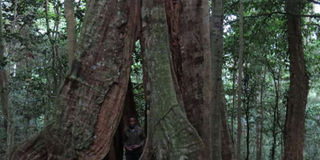In the shelter of the tree-cave

The gigantic Aningeria adolfi in Ngangao. PHOTO| RUPI MANGAT
What you need to know:
- There’s no life here, just a plantation of trees to be farmed and the spiny leaf litter of the exotic trees slippery to walk on.
- Once through it, we’re back in another part of the indigenous forest and by a gigantic cave.
“It’s the nest of Taita thrush,” whispers Handrison Mwameso, our guide. He’s from the Dawida Biodiversity Conservation group (DABICO). We’re inside Ngangao forest on the high peaks of the Taita Hills in southeast Kenya.
We’ve walked a few metres from our campsite into the forest, entering though a narrow path shaded by a bunch of Phoenix reclinata, a common palm tree here.
Taita thrush is another of the ‘only found in the indigenous forests of the Taita Hills’ wildlife. To the untrained eye, the nest is just a bunch of twigs and dry grasses high on a tree.
Ngangao is the largest of the indigenous forests. Mwameso guides me to the tallest tree in the indigenous forest, nicknamed ‘mother tree’ by the locals. It’s a Newtonia buchananii. I strain my neck to see its flat-topped canopy, but it’s impossible. All I see is a moss- and lichen-clad solid trunk breaking through the forest canopy. The guess is that it’s more than 130 feet tall.
BEAUTIFUL ANCIENT FOREST
It’s quiet inside the beautiful ancient forest, with just the bird chirp and the crinkle of leaves as we step on them. At night, the forest comes alive with bushbabies and other nocturnal animals calling out.
We wander around enjoying the beauty of the patterned forest floor with leaves and roots, fallen trees, standing trees, wild flowers, fluttering butterflies and camouflaged chameleons. It changes suddenly when we get to a pine plantation.
There’s no life here, just a plantation of trees to be farmed and the spiny leaf litter of the exotic trees slippery to walk on. Once through it, we’re back in another part of the indigenous forest and by a gigantic cave.
Carefully making our way down to the bottom and inside the cave, we search for any sign of rock paintings or skulls of the Taita but it’s empty, with just a steady stream of water flowing from the top.
Walking back, Mwameso leads the way to the highest point of Ngangao on the bare rock face of the ancient crystalline mountains that came into being some 260 million years ago.
From here the peaks of Vuria, Msindunyi and Iyale show where the last of the indigenous forest remain and its wildlife. It’s a tiny world – only one per cent - compared to the surrounding landscape of exotic forest plantations, farms and towns.
By now the sky is darkening; we should start heading back when Mwameso excitedly points to another gigantic tree. Just as we get to it, huge fat raindrops begin to fall. We’re caught in the rain.
The tree is hollow and for the next hour we while our time in it, watching the rain and the gale blow the plants – and yet we’re completely dry. The tree is big enough for us to wander around it.
“There’s a folklore attached to this tree,” says Mwameso. It’s about a herds’ boy sent out by his father to tend the livestock. In the forest, the boy finds a little antelope caught in a hunter’s trap.
The boy lets it loose and tells his father about the incident. The angry father asks the boy to climb the tall tree and when the boy is on the top, the father removes the ladder. It’s punishment for letting the animal go.
But in flies a big bird and rescues the boy who grows up to become a wealthy man with many cattle. One day he hears that his father is sick and he returns to help.
His father is ashamed of his mean behaviour and asks for forgiveness.
The tree that offers us a refuge is the Aningeria adolfi, or the muna tree, once common in places like Limuru.
Today there are only three standing in Tigoni, and nowhere as large as the one we’ve been in.
www.rupitheafricantrotter.wordpress.com




